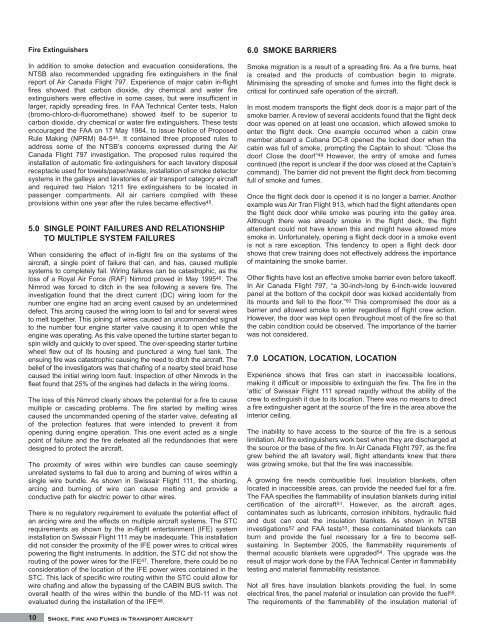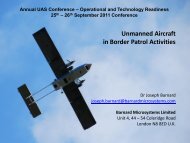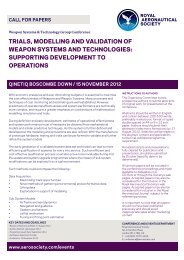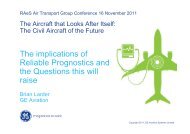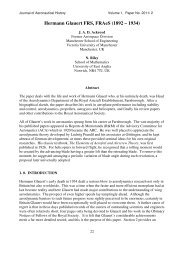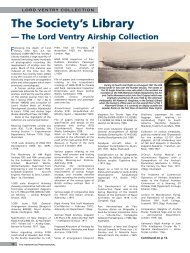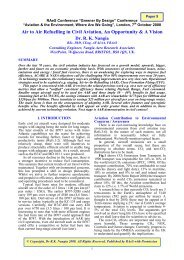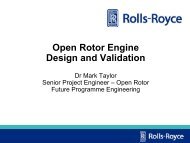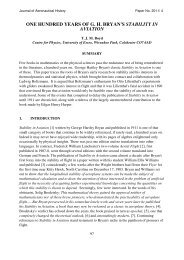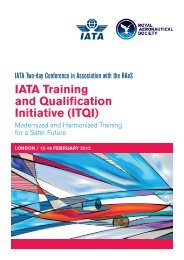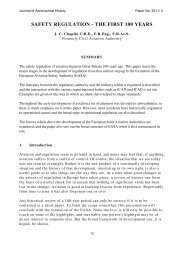Smoke, Fire and Fumes in Transport Aircraft - Royal Aeronautical ...
Smoke, Fire and Fumes in Transport Aircraft - Royal Aeronautical ...
Smoke, Fire and Fumes in Transport Aircraft - Royal Aeronautical ...
You also want an ePaper? Increase the reach of your titles
YUMPU automatically turns print PDFs into web optimized ePapers that Google loves.
<strong>Fire</strong> Ext<strong>in</strong>guishers<br />
In addition to smoke detection <strong>and</strong> evacuation considerations, the<br />
NTSB also recommended upgrad<strong>in</strong>g fire ext<strong>in</strong>guishers <strong>in</strong> the f<strong>in</strong>al<br />
report of Air Canada Flight 797. Experience of major cab<strong>in</strong> <strong>in</strong>-flight<br />
fires showed that carbon dioxide, dry chemical <strong>and</strong> water fire<br />
ext<strong>in</strong>guishers were effective <strong>in</strong> some cases, but were <strong>in</strong>sufficient <strong>in</strong><br />
larger, rapidly spread<strong>in</strong>g fires. In FAA Technical Center tests, Halon<br />
(bromo-chloro-di-fluoromethane) showed itself to be superior to<br />
carbon dioxide, dry chemical or water fire ext<strong>in</strong>guishers. These tests<br />
encouraged the FAA on 17 May 1984, to issue Notice of Proposed<br />
Rule Mak<strong>in</strong>g (NPRM) 84-5 44. It conta<strong>in</strong>ed three proposed rules to<br />
address some of the NTSB’s concerns expressed dur<strong>in</strong>g the Air<br />
Canada Flight 797 <strong>in</strong>vestigation. The proposed rules required the<br />
<strong>in</strong>stallation of automatic fire ext<strong>in</strong>guishers for each lavatory disposal<br />
receptacle used for towels/paper/waste, <strong>in</strong>stallation of smoke detector<br />
systems <strong>in</strong> the galleys <strong>and</strong> lavatories of air transport category aircraft<br />
<strong>and</strong> required two Halon 1211 fire ext<strong>in</strong>guishers to be located <strong>in</strong><br />
passenger compartments. All air carriers complied with these<br />
provisions with<strong>in</strong> one year after the rules became effective 45.<br />
5.0 SINGLE POINT FAILURES AND RELATIONSHIP<br />
TO MULTIPLE SYSTEM FAILURES<br />
When consider<strong>in</strong>g the effect of <strong>in</strong>-flight fire on the systems of the<br />
aircraft, a s<strong>in</strong>gle po<strong>in</strong>t of failure that can, <strong>and</strong> has, caused multiple<br />
systems to completely fail. Wir<strong>in</strong>g failures can be catastrophic, as the<br />
loss of a <strong>Royal</strong> Air Force (RAF) Nimrod proved <strong>in</strong> May 1995 46. The<br />
Nimrod was forced to ditch <strong>in</strong> the sea follow<strong>in</strong>g a severe fire. The<br />
<strong>in</strong>vestigation found that the direct current (DC) wir<strong>in</strong>g loom for the<br />
number one eng<strong>in</strong>e had an arc<strong>in</strong>g event caused by an undeterm<strong>in</strong>ed<br />
defect. This arc<strong>in</strong>g caused the wir<strong>in</strong>g loom to fail <strong>and</strong> for several wires<br />
to melt together. This jo<strong>in</strong><strong>in</strong>g of wires caused an uncomm<strong>and</strong>ed signal<br />
to the number four eng<strong>in</strong>e starter valve caus<strong>in</strong>g it to open while the<br />
eng<strong>in</strong>e was operat<strong>in</strong>g. As this valve opened the turb<strong>in</strong>e starter began to<br />
sp<strong>in</strong> wildly <strong>and</strong> quickly to over speed. The over-speed<strong>in</strong>g starter turb<strong>in</strong>e<br />
wheel flew out of its hous<strong>in</strong>g <strong>and</strong> punctured a w<strong>in</strong>g fuel tank. The<br />
ensu<strong>in</strong>g fire was catastrophic caus<strong>in</strong>g the need to ditch the aircraft. The<br />
belief of the <strong>in</strong>vestigators was that chaf<strong>in</strong>g of a nearby steel braid hose<br />
caused the <strong>in</strong>itial wir<strong>in</strong>g loom fault. Inspection of other Nimrods <strong>in</strong> the<br />
fleet found that 25% of the eng<strong>in</strong>es had defects <strong>in</strong> the wir<strong>in</strong>g looms.<br />
The loss of this Nimrod clearly shows the potential for a fire to cause<br />
multiple or cascad<strong>in</strong>g problems. The fire started by melt<strong>in</strong>g wires<br />
caused the uncomm<strong>and</strong>ed open<strong>in</strong>g of the starter valve, defeat<strong>in</strong>g all<br />
of the protection features that were <strong>in</strong>tended to prevent it from<br />
open<strong>in</strong>g dur<strong>in</strong>g eng<strong>in</strong>e operation. This one event acted as a s<strong>in</strong>gle<br />
po<strong>in</strong>t of failure <strong>and</strong> the fire defeated all the redundancies that were<br />
designed to protect the aircraft.<br />
The proximity of wires with<strong>in</strong> wire bundles can cause seem<strong>in</strong>gly<br />
unrelated systems to fail due to arc<strong>in</strong>g <strong>and</strong> burn<strong>in</strong>g of wires with<strong>in</strong> a<br />
s<strong>in</strong>gle wire bundle. As shown <strong>in</strong> Swissair Flight 111, the short<strong>in</strong>g,<br />
arc<strong>in</strong>g <strong>and</strong> burn<strong>in</strong>g of wire can cause melt<strong>in</strong>g <strong>and</strong> provide a<br />
conductive path for electric power to other wires.<br />
There is no regulatory requirement to evaluate the potential effect of<br />
an arc<strong>in</strong>g wire <strong>and</strong> the effects on multiple aircraft systems. The STC<br />
requirements as shown by the <strong>in</strong>-flight enterta<strong>in</strong>ment (IFE) system<br />
<strong>in</strong>stallation on Swissair Flight 111 may be <strong>in</strong>adequate. This <strong>in</strong>stallation<br />
did not consider the proximity of the IFE power wires to critical wires<br />
power<strong>in</strong>g the flight <strong>in</strong>struments. In addition, the STC did not show the<br />
rout<strong>in</strong>g of the power wires for the IFE 47. Therefore, there could be no<br />
consideration of the location of the IFE power wires conta<strong>in</strong>ed <strong>in</strong> the<br />
STC. This lack of specific wire rout<strong>in</strong>g with<strong>in</strong> the STC could allow for<br />
wire chaf<strong>in</strong>g <strong>and</strong> allow the bypass<strong>in</strong>g of the CABIN BUS switch. The<br />
overall health of the wires with<strong>in</strong> the bundle of the MD-11 was not<br />
evaluated dur<strong>in</strong>g the <strong>in</strong>stallation of the IFE 48.<br />
10<br />
<strong>Smoke</strong>, <strong>Fire</strong> <strong>and</strong> <strong>Fumes</strong> <strong>in</strong> <strong>Transport</strong> <strong>Aircraft</strong><br />
6.0 SMOKE BARRIERS<br />
<strong>Smoke</strong> migration is a result of a spread<strong>in</strong>g fire. As a fire burns, heat<br />
is created <strong>and</strong> the products of combustion beg<strong>in</strong> to migrate.<br />
M<strong>in</strong>imis<strong>in</strong>g the spread<strong>in</strong>g of smoke <strong>and</strong> fumes <strong>in</strong>to the flight deck is<br />
critical for cont<strong>in</strong>ued safe operation of the aircraft.<br />
In most modern transports the flight deck door is a major part of the<br />
smoke barrier. A review of several accidents found that the flight deck<br />
door was opened on at least one occasion, which allowed smoke to<br />
enter the flight deck. One example occurred when a cab<strong>in</strong> crew<br />
member aboard a Cubana DC-8 opened the locked door when the<br />
cab<strong>in</strong> was full of smoke, prompt<strong>in</strong>g the Capta<strong>in</strong> to shout: “Close the<br />
door! Close the door!” 49 However, the entry of smoke <strong>and</strong> fumes<br />
cont<strong>in</strong>ued (the report is unclear if the door was closed at the Capta<strong>in</strong>’s<br />
comm<strong>and</strong>). The barrier did not prevent the flight deck from becom<strong>in</strong>g<br />
full of smoke <strong>and</strong> fumes.<br />
Once the flight deck door is opened it is no longer a barrier. Another<br />
example was Air Tran Flight 913, which had the flight attendants open<br />
the flight deck door while smoke was pour<strong>in</strong>g <strong>in</strong>to the galley area.<br />
Although there was already smoke <strong>in</strong> the flight deck, the flight<br />
attendant could not have known this <strong>and</strong> might have allowed more<br />
smoke <strong>in</strong>. Unfortunately, open<strong>in</strong>g a flight deck door <strong>in</strong> a smoke event<br />
is not a rare exception. This tendency to open a flight deck door<br />
shows that crew tra<strong>in</strong><strong>in</strong>g does not effectively address the importance<br />
of ma<strong>in</strong>ta<strong>in</strong><strong>in</strong>g the smoke barrier.<br />
Other flights have lost an effective smoke barrier even before takeoff.<br />
In Air Canada Flight 797, “a 30-<strong>in</strong>ch-long by 6-<strong>in</strong>ch-wide louvered<br />
panel at the bottom of the cockpit door was kicked accidentally from<br />
its mounts <strong>and</strong> fell to the floor.” 50 This compromised the door as a<br />
barrier <strong>and</strong> allowed smoke to enter regardless of flight crew action.<br />
However, the door was kept open throughout most of the fire so that<br />
the cab<strong>in</strong> condition could be observed. The importance of the barrier<br />
was not considered.<br />
7.0 LOCATION, LOCATION, LOCATION<br />
Experience shows that fires can start <strong>in</strong> <strong>in</strong>accessible locations,<br />
mak<strong>in</strong>g it difficult or impossible to ext<strong>in</strong>guish the fire. The fire <strong>in</strong> the<br />
‘attic’ of Swissair Flight 111 spread rapidly without the ability of the<br />
crew to ext<strong>in</strong>guish it due to its location. There was no means to direct<br />
a fire ext<strong>in</strong>guisher agent at the source of the fire <strong>in</strong> the area above the<br />
<strong>in</strong>terior ceil<strong>in</strong>g.<br />
The <strong>in</strong>ability to have access to the source of the fire is a serious<br />
limitation. All fire ext<strong>in</strong>guishers work best when they are discharged at<br />
the source or the base of the fire. In Air Canada Flight 797, as the fire<br />
grew beh<strong>in</strong>d the aft lavatory wall, flight attendants knew that there<br />
was grow<strong>in</strong>g smoke, but that the fire was <strong>in</strong>accessible.<br />
A grow<strong>in</strong>g fire needs combustible fuel. Insulation blankets, often<br />
located <strong>in</strong> <strong>in</strong>accessible areas, can provide the needed fuel for a fire.<br />
The FAA specifies the flammability of <strong>in</strong>sulation blankets dur<strong>in</strong>g <strong>in</strong>itial<br />
certification of the aircraft 51. However, as the aircraft ages,<br />
contam<strong>in</strong>ates such as lubricants, corrosion <strong>in</strong>hibitors, hydraulic fluid<br />
<strong>and</strong> dust can coat the <strong>in</strong>sulation blankets. As shown <strong>in</strong> NTSB<br />
<strong>in</strong>vestigations 52 <strong>and</strong> FAA tests 53, these contam<strong>in</strong>ated blankets can<br />
burn <strong>and</strong> provide the fuel necessary for a fire to become selfsusta<strong>in</strong><strong>in</strong>g.<br />
In September 2005, the flammability requirements of<br />
thermal acoustic blankets were upgraded 54. This upgrade was the<br />
result of major work done by the FAA Technical Center <strong>in</strong> flammability<br />
test<strong>in</strong>g <strong>and</strong> material flammability resistance.<br />
Not all fires have <strong>in</strong>sulation blankets provid<strong>in</strong>g the fuel. In some<br />
electrical fires, the panel material or <strong>in</strong>sulation can provide the fuel 55.<br />
The requirements of the flammability of the <strong>in</strong>sulation material of


